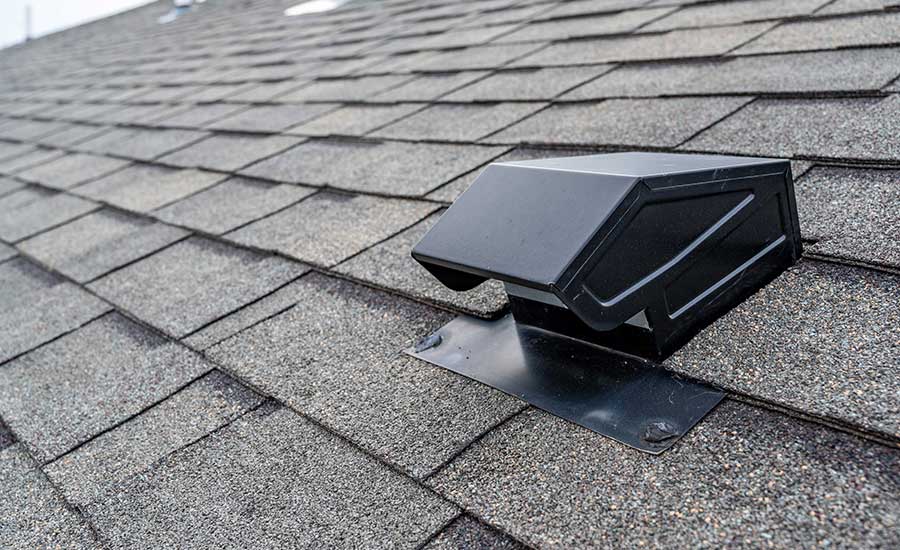Not only does attic ventilation protect your home from costly damage, but it also improves energy efficiency and indoor air quality.
In this article, we will discuss the benefits of proper attic ventilation and how it can help you save money while also improving the overall health of your home.
What Is Attic Ventilation?
Attic ventilation is all about giving your attic a way to breathe. Just as you and every other human need air to breathe, your attic needs air to circulate to keep it healthy.
For instance, your attic can become extremely hot in the summer and extremely cold in the winter. Under such circumstances, problems could occur around your home if the air doesn’t circulate properly.
Think of it like this, if you were trapped in a small room with no windows or doors to open, it would quickly become stuffy and uncomfortable. The same thing happens in an attic with no ventilation. The heat and moisture can build up and cause damage to the roof and insulation.
So, in summary, attic ventilation is like giving your attic a way to breathe by allowing air to circulate in and out through vents. This helps to keep the attic at a safe temperature and prevent damage from heat and moisture.
How Attic Ventilation Works
Attic ventilation works by regulating the flow of air in the attic space. The ventilation system achieves this with the aid of intake and exhaust vents.
Intake vents near the roof’s eaves or soffits allow cool, fresh air to enter the attic. Meanwhile, exhaust vents, typically located at the roof’s peak or in the gable ends, allow hot, stale air to escape the attic.
When the attic is properly ventilated, the cool air that enters through the intake vents creates a flow of air that moves upward, pushing the hot air out through the exhaust vents.
When the warm air rises and exits the building through the vents, it creates negative pressure on the lower floors. This negative pressure causes the cool air to enter the attic through the intake vents.
An essential principle of attic ventilation is the intake and exhaust venting balance.
A common rule of thumb is to have 1 square foot of net-free ventilation area for every 150 square feet of attic floor space. This means that if you have an attic that is 1500 square feet, you should have at least 10 square feet of net free ventilation area.
Benefits Of Having a Proper Attic Ventilation
Here are some of the benefits of having a proper attic ventilation system.
· Energy Efficiency
Proper attic ventilation can help you save money on energy costs by keeping the attic at a more constant temperature. In the summer, hot air can fill the attic, causing your air conditioner to work harder to cool your home.
With a proper ventilation system, you can remove hot air before entering your living space. Consequently, this can potentially help to lower your energy bills.
· Longevity of the Roof
Proper attic ventilation can help extend your roof’s life by preventing moisture buildup. When too much moisture builds up on your roof, it can cause rot, mold, and other damage to the roof deck and rafters. This can result in leaks and other issues that may be costly to repair.
By ventilating the attic, you can prevent moisture from building up. Eventually, this will help to protect your roof and extend its life.
· Improved Indoor Air Quality
Since it helps remove moisture, mold, and mildew, proper attic ventilation can help improve your home’s indoor air quality.
As long as you have proper attic ventilation, you won’t need to worry about health problems like allergies and asthma.
· Reduction of Ice Damming
Proper attic ventilation can help to reduce the risk of ice dams forming on your roof during the winter. Ice dams occur when heat from the attic melts snow on the roof and then refreezes at the roof’s edge.
This results in creating a dam that can cause leaks and other damage. By ventilating the attic, you can help to keep the attic at a more moderate temperature, which can help to reduce the risk of ice dams forming.
· Protection of Insulation
Proper attic ventilation can help to protect the insulation in your attic from damage caused by moisture buildup. Moisture can cause the insulation to lose effectiveness, making your home less energy efficient.
By ventilating the attic, you can prevent moisture from accumulating, protecting your insulation and making your home more energy efficient.
Protection of the Attic’s Structure
Proper attic ventilation can help protect the attic’s structure from moisture damage. Moisture can cause rot, mold, and other structural damage in the attic, leading to leaks and other costly problems.
By ventilating the attic, you can prevent moisture from building up, which can help to protect the attic structure and the integrity of your home.
Conclusion
In summary, proper attic ventilation can save you money by lowering energy costs, extending the life of your roof, and improving indoor air quality. It can also help to reduce the risk of ice dams, protect your roof’s insulation, and preserve your attic’s structure.
Hence, it is important to ensure that you properly ventilate your attic to keep your home healthy and safe. If you need professional roofers to help you with your attic ventilation, call us at RoofPro at 250-248-3400 or fill out our contact form here.


